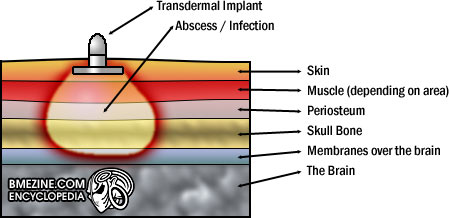Inward Traveling Infection
Normally when an infection develops in a body modification procedure, assuming there is some point of drainage (be it an abscess that has ruptured, or simply the exit point of the piercings), your body is very good at over time pushing the infection out of the body and healing successfully. That is, the infected tissue and bacteria travels out from the body, until less and less, and eventually none of it, is left in the body.
However, in rare cases (most commonly with implants and transdermal implants, an infection with difficulty in draining can travel inward and grow dramatically worse without you even knowing it. Here is a story of something that happened to someone after a transdermal implant went bad:
- A client gets a series of transdermal implants in a typical placement running up the center of his forehead. Over time, they heal, and appear to be doing well. Later they suffer an impact and swell up. The client (very fit and healthy) is briefly concerned, but the swelling goes down and he doesn't give it much more thought at the time.
- Some time goes by, and he starts getting headaches. After a while, they become unbearable, and dizziness and other problems begin to set in. He goes in to the hospital, where doctors quickly realize that even though they look outwardly fine, the problem lies in the forehead transdermal implants.
- Presumably because of an infection picked up during the injury, coupled perhaps by weakening of the underlying tissue, the infection didn't go away — it simply moved inward instead. By the time he got to the hospital, a hole over half an inch in diameter had already been eaten through his skull. If he'd put off the hospital visit for another week he could have easily died.
The person in the story above is fine now, and actually opted to keep several of the unaffected implants in place to the best of my knowledge. However, he does now have a plate in his skull! The diagram above is not at all to scale, but it illustrates the basic problem.
It can not be emphasized enough how incredibly important it is to monitor your healing (and healed) body modifications, be in good health, and generally "in tune" with what your body is doing.
See Also
- Mastitis (another form of inward-traveling infection)
- Salt Soaks (which can help draw out an infection)
